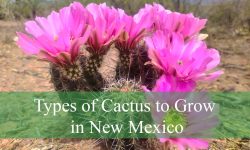Mimosa trees are known for their delicate, feathery leaves and vibrant, showy flowers. These trees belong to the Mimosa genus in the Fabaceae family and are celebrated for their beauty and ability to thrive in various climates. Whether you’re an avid gardener or simply curious about these unique trees, understanding their different types can help you identify them and appreciate their various features.
In this article, we’ll explore 11 types of mimosa trees, offering helpful tips on how to recognize each one.
Different Types of Mimosa Trees
Mimosa microphylla
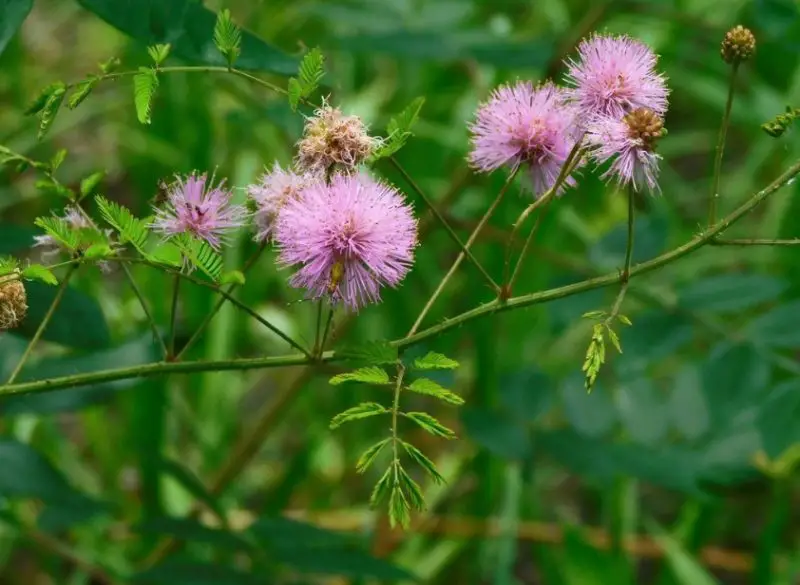
Mimosa microphylla, commonly known as Littleleaf Sensitive-Briar, is a low-growing, trailing vine in the Fabaceae family. Native to the southeastern United States, it is often found in sandy soils, open woodlands, grasslands, and along roadsides.
This plant features slender, wiry stems covered in small, hooked thorns that help it climb and sprawl across the ground. Its delicate, bipinnate leaves are highly sensitive to touch, quickly folding when disturbed, a defensive mechanism that helps deter herbivores.
In late spring and summer, Littleleaf Sensitive-Briar produces striking pink to purple, spherical flower clusters resembling small pom-poms. These flowers are rich in nectar and attract a variety of pollinators, including bees and butterflies. After flowering, the plant develops elongated seed pods covered in tiny bristles, which aid in seed dispersal.
Despite its thorny nature, Mimosa microphylla is an ecologically beneficial plant, helping prevent soil erosion and providing food and habitat for insects and small wildlife. Its ability to thrive in poor soils and dry conditions makes it a resilient species in its native range.
Mimosa nuttallii
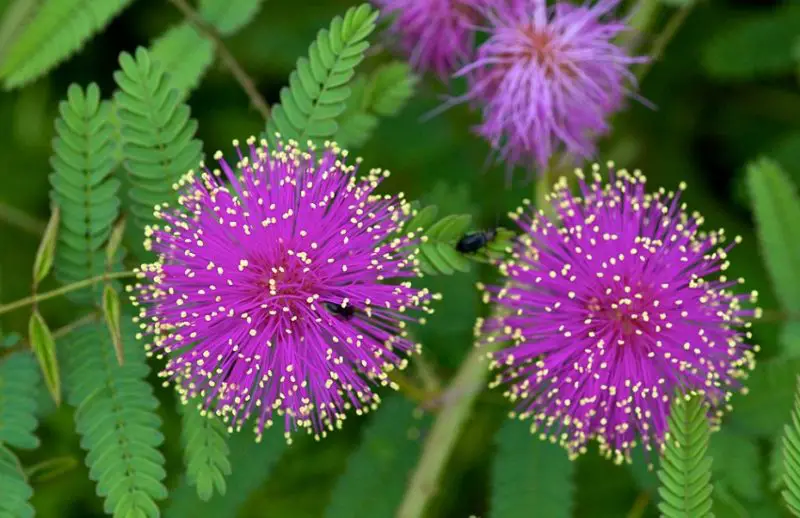
Mimosa nuttallii, commonly known as Nuttall’s Sensitive-Briar, is a perennial, trailing vine in the Fabaceae family. It is native to central and southern regions of North America, thriving in prairies, grasslands, and open woodlands.
This plant has slender, sprawling stems covered in small, curved thorns that help it cling to surrounding vegetation. Its bipinnate leaves are highly sensitive and fold inward when touched, a unique characteristic of the Mimosa genus that helps deter herbivores.
During late spring and summer, Nuttall’s Sensitive-Briar produces vibrant pink to purple, ball-shaped flowers with numerous thread-like stamens, giving them a delicate, feathery appearance. These nectar-rich flowers attract various pollinators, including bees and butterflies. After blooming, the plant develops seed pods covered in tiny bristles, aiding in seed dispersal by attaching to animals and passing vehicles.
Despite its thorny stems, Mimosa nuttallii is an important species for prairie ecosystems, helping prevent soil erosion and providing shelter for insects and small wildlife. Its deep roots allow it to tolerate dry, sandy, or rocky soils, making it a resilient and ecologically valuable plant in its native habitats.
Mimosa ophthalmocentra
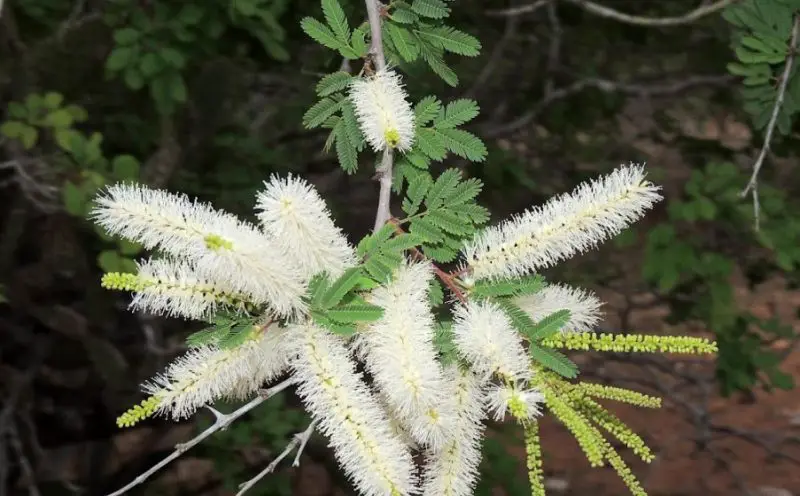
Mimosa ophthalmocentra, commonly known as Jurema-Embira, is a thorny shrub or small tree belonging to the Fabaceae family. It is native to the dry Caatinga biome of northeastern Brazil, where it thrives in arid and semi-arid conditions.
This plant typically grows between 2 to 5 meters tall, with multiple branches covered in sharp, recurved thorns. Its bipinnate leaves are small and feathery, adapting well to drought conditions by reducing water loss. Like other Mimosa species, its leaves exhibit rapid movement, folding when touched, a defense mechanism against herbivores.
Jurema-Embira produces small, round, pale yellow or cream-colored flower clusters, rich in nectar and attracting pollinators like bees and butterflies. After flowering, it develops elongated seed pods that harden as they mature, aiding in seed dispersal through wind and animals.
Due to its deep root system, Mimosa ophthalmocentra plays a crucial role in preventing soil erosion and stabilizing degraded landscapes. It is also valued for its hard, dense wood, often used for charcoal production, fencing, and traditional medicine. Despite its thorny nature, this species is an important ecological and economic resource in its native region.
Mimosa aculeaticarpa
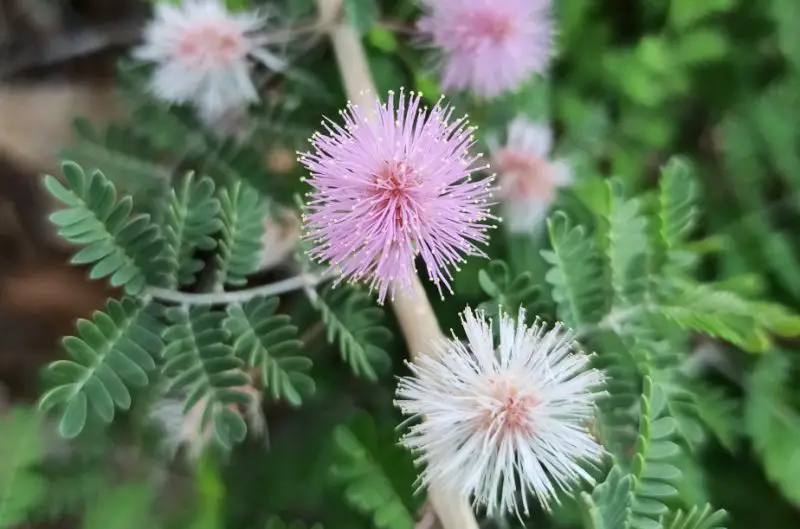
Mimosa aculeaticarpa, commonly known as Catclaw Mimosa, is a shrub species in the Fabaceae family, native to arid regions of North America, particularly in the southwestern United States and northern Mexico.
This plant typically grows to a height of 1 to 2 meters, with a dense, spreading form. Its branches are covered with small, curved thorns resembling a cat’s claw, which help it climb and protect it from herbivores. The leaves are small, bipinnate, and feathery, giving the plant a delicate appearance despite its thorny nature.
Catclaw Mimosa produces clusters of pink to purplish spherical flowers, which bloom primarily in spring and summer. These flowers are rich in nectar, attracting bees, butterflies, and other pollinators. After flowering, the plant develops small, flat seed pods that disperse with the help of wind and animals.
This hardy shrub is well-adapted to dry, rocky, and sandy soils, often found in desert scrublands, grasslands, and along washes. It plays an essential role in preventing soil erosion and providing shelter and food for wildlife. Despite its spiny defenses, Catclaw Mimosa is valued for its ecological benefits and ability to thrive in harsh environments.
Mimosa diplotricha

Mimosa diplotricha, commonly known as the Giant Sensitive Plant, is a fast-growing, thorny shrub belonging to the Fabaceae family. Native to South America, it has spread to tropical and subtropical regions worldwide, often becoming an invasive species.
This plant can grow up to 3 meters tall, with long, trailing or climbing stems covered in sharp, recurved thorns. Its leaves are bipinnate, sensitive to touch, and quickly fold when disturbed, a characteristic trait of the Mimosa genus. This movement helps protect the plant from herbivores and environmental stress.
Giant Sensitive Plant produces small, round, pink to purplish flowers that bloom in clusters. These flowers attract pollinators such as bees and butterflies. After flowering, it develops elongated seed pods covered in bristles, which easily attach to animals and human clothing, aiding in seed dispersal.
Due to its rapid growth and aggressive spreading, Mimosa diplotricha is considered a serious weed in many regions. It thrives in disturbed areas, roadsides, and agricultural lands, forming dense thickets that outcompete native vegetation. However, it also plays a role in soil improvement by fixing nitrogen, making it both a problematic invader and a potential soil-enriching species.
Mimosa quadrivalvis
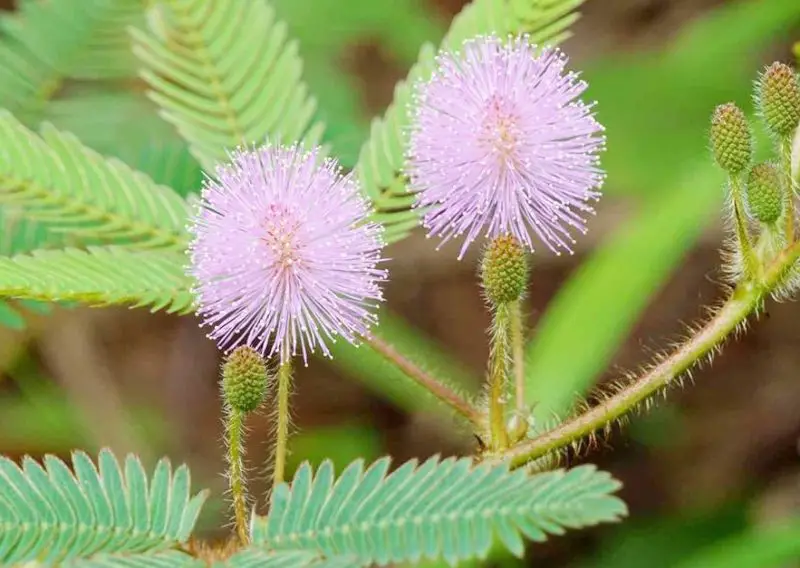
Mimosa quadrivalvis, commonly known as Fourvalve Mimosa, is a trailing or climbing perennial vine in the Fabaceae family. It is native to North and Central America, often found in sandy soils, grasslands, open woodlands, and along roadsides.
This plant has slender, sprawling stems covered in sharp, curved thorns that help it climb and spread across the ground. Its bipinnate leaves are delicate and sensitive to touch, folding inward when disturbed, a characteristic defense mechanism of many Mimosa species.
In late spring and summer, Fourvalve Mimosa produces spherical, pink to purplish flower clusters composed of numerous thread-like stamens, giving them a feathery appearance. These flowers attract various pollinators, including bees and butterflies. After flowering, the plant develops segmented seed pods, each containing four distinct sections (or valves), which contribute to its name. These pods are covered in small bristles, aiding in seed dispersal by clinging to animals and human clothing.
Despite its thorny growth, Mimosa quadrivalvis is ecologically valuable, helping prevent soil erosion and providing habitat for insects and small wildlife. Its ability to thrive in dry, nutrient-poor soils makes it a resilient species in its native habitats.
Mimosa strigillosa
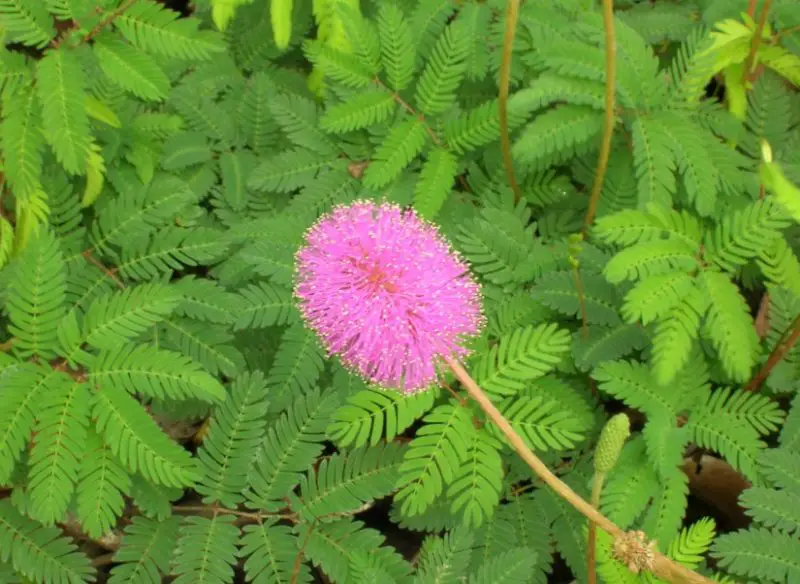
Mimosa strigillosa, commonly known as Sunshine Mimosa, is a low-growing, spreading perennial plant in the Fabaceae family. Native to the southeastern United States, it is often found in sandy, well-drained soils in prairies, roadsides, and open woodlands.
This plant typically forms a dense, ground-hugging mat, with slender, trailing stems and small, bipinnate leaves that are sensitive to touch, folding inward when disturbed. The leaves, with their feathery appearance, give the plant a delicate yet resilient look.
Sunshine Mimosa produces vibrant pink to purple, ball-shaped flower clusters that bloom in spring and summer. These flowers are rich in nectar and attract a variety of pollinators, including bees and butterflies. After blooming, the plant produces small seed pods that are covered in tiny bristles, which assist in seed dispersal.
Mimosa strigillosa is well-adapted to hot, dry conditions and is valued for its ability to stabilize soil, prevent erosion, and create ground cover in disturbed areas. Despite its low-growing habit, it is an ecologically significant species, providing habitat for insects and small wildlife. Its bright flowers and rapid growth also make it an attractive addition to gardens and landscaping in its native range.
Mimosa rubicaulis
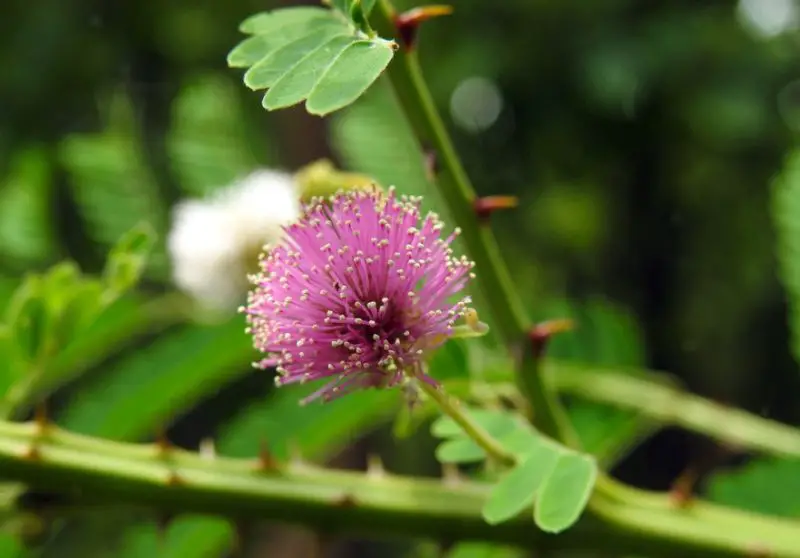
Mimosa rubicaulis, commonly known as Himalayan Mimosa, is a small to medium-sized shrub in the Fabaceae family, native to the Himalayan region, particularly in India, Nepal, and surrounding areas. This species is often found in forests, along riverbanks, and in subtropical and tropical climates.
Himalayan Mimosa has a bushy, sprawling form, typically growing between 1 to 3 meters tall. Its branches are densely covered with fine, straight thorns, which help protect it from browsing animals. The plant’s bipinnate leaves are small, feathery, and highly sensitive, folding inward when touched, a characteristic behavior of the Mimosa genus.
During the flowering season, Mimosa rubicaulis produces clusters of vibrant pink to purple, spherical flowers. These flowers are rich in nectar, attracting bees, butterflies, and other pollinators. After blooming, it produces elongated, flat seed pods, which contain numerous seeds that are dispersed by wind and animals.
This species thrives in a variety of soils, from moist to dry, and is known for its resilience and ability to grow quickly in disturbed areas. Himalayan Mimosa is an important part of its native ecosystem, helping prevent soil erosion and providing food and shelter for various wildlife species. Despite its somewhat invasive tendencies in non-native areas, it remains an ecologically valuable species in its native range.
Mimosa scabrella
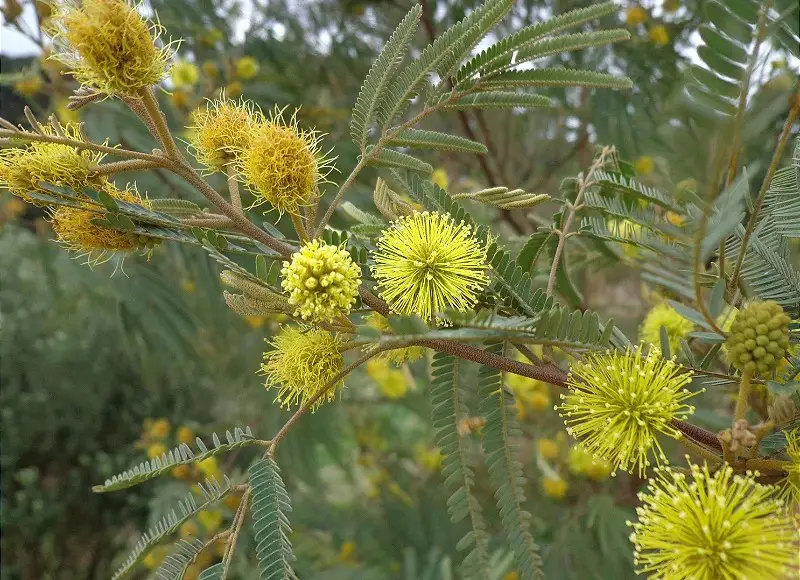
Mimosa scabrella, commonly known as Bracatinga Mimosa, is a medium-sized tree native to the southern regions of Brazil, particularly in the Atlantic Forest. This species is commonly found in areas with well-drained soils, including forests, riverbanks, and disturbed lands.
Bracatinga Mimosa typically grows to a height of 10 to 20 meters, with a straight, tall trunk and a broad canopy. The branches are often covered with fine, soft thorns, providing protection from herbivores. Its leaves are bipinnate, consisting of small, delicate leaflets arranged in pairs, which exhibit sensitivity to touch, folding inward when disturbed.
The tree produces striking, yellow to orange, spherical flower clusters in the spring and summer, which are rich in nectar and attract pollinators like bees and butterflies. After flowering, it forms long, cylindrical seed pods, which are dispersed by wind or animals.
Mimosa scabrella is an important species in its native ecosystem, helping to prevent soil erosion with its deep root system. It also contributes to soil enrichment by fixing nitrogen, making it valuable for agroforestry systems and reforestation projects. The wood of Bracatinga Mimosa is used for various purposes, including furniture, charcoal production, and as firewood. Despite its ecological benefits, the species is also known to be invasive in some areas outside its native range.
Mimosa pudica
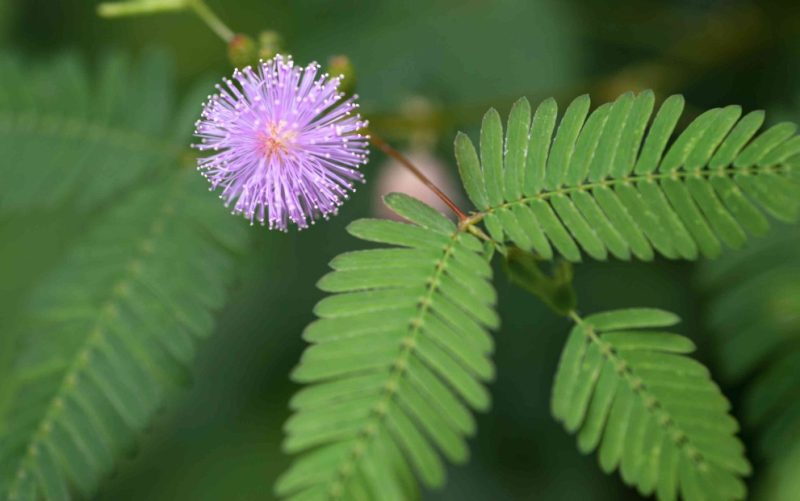
Mimosa pudica, commonly known as the Humble Plant, Sensitive Plant, or Touch-Me-Not, is a small, herbaceous perennial in the Fabaceae family. It is native to Central and South America but has spread to tropical and subtropical regions around the world, often growing in disturbed areas, roadsides, and gardens.
This plant is easily recognized by its delicate, fern-like leaves, which are bipinnate and composed of small, oval leaflets. One of the most distinctive features of Mimosa pudica is its sensitivity to touch. The leaves fold inward and droop when touched or disturbed, an adaptation thought to protect the plant from herbivores or harsh environmental conditions.
In the summer, the plant produces small, pink or purple spherical flower clusters, which are attractive to bees and butterflies. After flowering, it produces elongated seed pods that are covered in tiny, bristly hairs, aiding in seed dispersal by attaching to animals or passing vehicles.
Mimosa pudica is often grown as an ornamental plant due to its fascinating leaf movements and attractive flowers. It also has medicinal uses in traditional medicine, particularly in parts of Asia and South America, where it is used for its purported anti-inflammatory and calming properties. While it is popular in gardens, it can also be invasive in certain areas, spreading quickly in disturbed soils.


